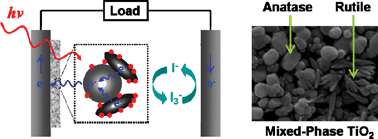A synergistic effect between anatase and rutile TiO2 is known, in which the addition of rutile can remarkably enhance the photocatalytic activity of anatase in the degradation of organic contaminants. In this study, mixed-phase TiO2 nanocomposites consisting of anatase and rutile nanoparticles (NPs) were prepared for use as photoanodes in dye-sensitized solar cells (DSSCs) and were characterized by using UV-vis spectroscopy, powder X-ray diffraction and scanning electron microscopy. The addition of 10–15% rutile significantly improved light harvesting and the overall solar conversion efficiency of anatase NPs in DSSCs. The underlying mechanism for the synergistic effect in DSSCs is now explored by using time-resolved terahertz spectroscopy. It is clearly demonstrated that photo-excited electrons injected into the rutile NPs can migrate to the conduction band of anatase NPs, enhancing the photocurrent and efficiency. Interfacial electron transfer from rutile to anatase, similar to that in heterogeneous photocatalysis, is proposed to account for the synergistic effect in DSSCs. Our results further suggest that the synergistic effect can be used to explain the beneficial effect of TiCl4 treatment on DSSC efficiency.

You have access to this article
 Please wait while we load your content...
Something went wrong. Try again?
Please wait while we load your content...
Something went wrong. Try again?


 Please wait while we load your content...
Please wait while we load your content...